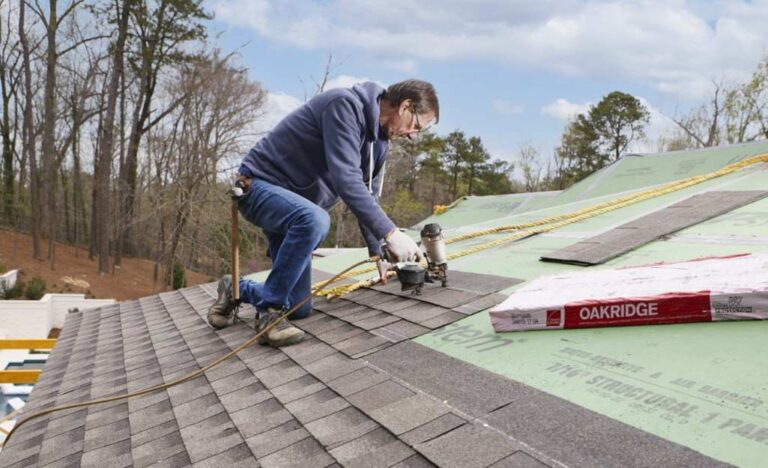Let’s talk roof access. Not the most thrilling part of a remodel, I know, but it definitely belongs on your to-do list whether you’re a homeowner, project manager, or part of the construction crew.
I’ve heard plenty of stories from folks halfway through renovations who suddenly wished their roof access was better.
It comes up more often than you’d think, including adding solar panels, upgrading insulation, turning the attic into a workspace, or making maintenance less of a hassle.
Getting this right early means fewer headaches later on.
Plus, exploring your options can be interesting and might even save you some money down the line.
Roof Access Hatch
A roof access hatch is a compact door built into your roof that opens from the inside, acting like a secret passage to your shingles—without any hassle.
It’s perfect for flat or low-slope roofs and usually sits just above an indoor stairway or fixed ladder, making rooftop access straightforward and dependable.
What really sets it apart is how clean and unobtrusive it looks from the outside.
Instead of bulky towers or awkward metal structures, most roof hatches have a sleek, weather-sealed cover that fits neatly into the roofline.
This design keeps the building’s exterior tidy and polished without calling attention to itself.
Beyond looks, it’s built to make rooftop tasks easier and safer.
From installing HVAC units performing maintenance to handling other rooftop equipment, a roof hatch provides quick, secure entry.
Many models include insulation to boost energy efficiency by reducing heat loss or gain through the opening.
Built-in handles make opening and closing smooth and simple, while locking mechanisms keep the hatch secure, protecting your equipment and limiting access to authorized personnel only.
This combination of clean design and practical features makes roof hatches a smart choice for both modern homes and commercial spaces.
Fixed Interior Staircases
A fixed staircase gives you direct access to the attic or roof deck, just like any other stairway in the house.
It follows standard dimensions, with even steps and handrails for support.
Since it’s built into the home’s layout, it’s important to think through the location early, especially in terms of ceiling height and how it fits with the rooms around it.
It takes up more space than a pull-down ladder, but the tradeoff is reliable, everyday access that feels easy to use.
Pull-Down Attic Stairs
You’ve probably seen these in plenty of older homes—folding staircases that tuck neatly into the ceiling.
Pull-down attic stairs are perfect if you don’t need frequent access but still want a dependable way to reach the roof.
Today, many models use lightweight aluminum or reinforced stone wood house, with easy-lift mechanisms that don’t slam shut or creak every time you use them.
Just be sure to choose one rated for the weight of people and tools.
Some people add attic flooring around the opening to make roof prep days safer and more convenient.
Exterior Roof Ladders
Fixed exterior ladders are practical solutions for detached garages, sheds, or garden structures.
They attach securely to outside walls, easily getting up to the roof without going inside.
These ladders often support rooftop features like greenhouses, rainwater systems, or small solar panels.
Some even paint them to match the siding, so they blend right in.
Since they’re outside all year, it’s smart to choose corrosion-resistant materials that hold up through every season.
Skylights
This is where things get fancy. Some skylights open wide enough for a person to step through.
I’ve seen them work well in converted attics and top-floor bedrooms.
They look fantastic and double as a clever exit point.
The open-air feel shines, especially if you’re creating a small roof terrace or garden.
Ensure the opening meets code and the roof’s slope allows safe entry and exit.
Nobody wants to crawl through a window like it’s a spy movie.
Tips for Choosing Roof Access That Works for Your Remodel
Think About How Often You’ll Use It. Start with how frequently someone will need to reach the roof. Occasional visits might only call for a simple attic ladder or pull-down stairs. If you plan to be up there more regularly, something more permanent and comfortable makes more sense.
Remember Safety Features. Just like access doors and panels, roof hatches require safety features. When the space sees regular use, safety can’t be an afterthought. Even if you’re the only one climbing up now, having a secure and stable path helps avoid unexpected hazards. A well-designed setup with handholds, steady footing, and clear access makes every trip safer—not just today, but for anyone who needs to use it in the future.
Consider the Shape and Slope of the Roof. Flat and low-pitch roofs often allow more access options. Steeper ones might limit placement or require a safer interior-to exterior transition. The structure you’re working with usually points you in the right direction once you start sketching out what’s possible.
Pick a Spot That’s Easy to Reach Indoors. Access points tucked into hard-to-reach corners tend to get ignored. Think about daily movement in the home and choose a spot that doesn’t block traffic or require you to move furniture just to get up there.
Factor in What the Structure Can Support. Before making any cuts, check the framing and layout. Adding stairs or widening an opening might mean adjusting beams or rerouting electrical. Some plans need extra bracing to support the weight around the access area.
Conclusion
Roof access may not get the same attention as kitchen islands or bathroom tiles, but it plays a big part in how functional your space is.
And once it’s in place? You’ll wonder how you ever lived without it.
There’s something satisfying about walking up to the roof without dragging a ladder across the lawn or asking someone to hold it steady.
Good roof access makes your home safer, more efficient, and easier to maintain.
While you’re sketching out those remodel ideas, take a minute to think about how you’ll reach the top.



